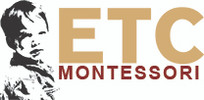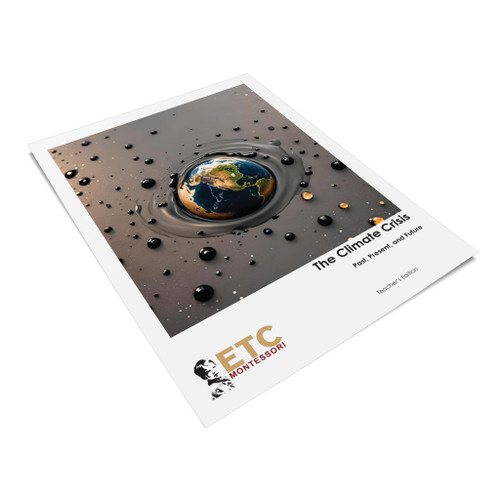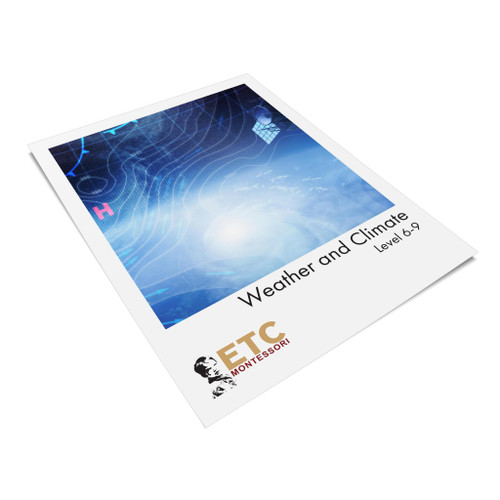Product Overview
For use with the Secondary I Y1: C1, C5 themes of Connections, Interdependence, and/or Y2: C4, C5 themes of Changes, and Balance
"The Climate Crisis: Past, Present, and Future" completes the study of climate, weather, and ecology. This material picks up from where "Weather and Climate, Level 9-12" stops and moves the study of climate change into the Middle school environment. It serves as an essential resource designed to provide a comprehensive understanding of the historical, scientific, and socio-political dimensions of the climate crisis. This curriculum aligns with Common Core State Standards (CCSS) and Next Generation Science Standards (NGSS) for grades 6-8, offering a multidisciplinary approach to teaching climate change.
Key Features:
-
Historical Context:
- Colonial Era and Industrial Revolution: Examines the roots of the contemporary climate crisis, tracing back to the late 15th century European colonization and the Industrial Revolution. Discusses how the exploitation of natural resources and the rise of fossil fuel consumption have historically contributed to global warming.
- Significant Events and Figures: Highlights key historical events such as the establishment of the first commercial oil well and significant figures like René Descartes and his dualistic philosophy that influenced environmental exploitation.
-
Scientific Foundations:
- Greenhouse Effect: Introduces the foundational concepts of the greenhouse effect, first proposed by Jean-Baptiste Joseph Fourier, and its role in maintaining Earth's temperature.
- Modern Scientific Understanding: Explores advancements in climate science, including the role of greenhouse gases in climate change and the impact of human activities on global warming.
-
Socio-Political Dimensions:
- Environmental Justice: Discusses the complex relationship between environmental justice, policy, activism, and legal challenges. Examines the role of Indigenous movements, youth activism, and scientific assessments in shaping climate policies.
- Colonial Legacies: Analyzes the long-term impacts of colonial practices on the environment and the socio-political dynamics between European powers and indigenous populations.
-
Interdisciplinary Projects:
- Eco-Footprint Analysis: Students calculate their ecological footprint, analyze data, and develop action plans for sustainable living.
- Solar Oven Construction: A hands-on project teaching students about renewable energy by building and testing solar ovens.
- Weather and Climate Drama: Engages students in dramatizing weather phenomena and climate change impacts, fostering a deeper understanding through creative expression.
- Upcycled Art Exhibition: Promotes environmental sustainability through art projects using recycled materials.
- Community Garden Proposal: Students design a community garden, learning about sustainable agriculture and its benefits for carbon reduction and community health.
Educational Objectives:
- Critical Thinking: Encourages students to analyze historical and contemporary issues related to the climate crisis.
- Scientific Inquiry: Develops students' abilities to conduct research, analyze data, and understand scientific principles underlying climate change.
- Social Awareness: Fosters an understanding of the interconnectedness of social, economic, and environmental justice within the broader framework of climate change.
- Practical Application: Provides students with hands-on projects to apply their knowledge and promote sustainable practices in their communities.
- STEM Integration:
- Teacher's Edition with expanded concepts and notations
- Student edition
- Quiding Questions
- Projects
- Research and discussion Questions
- Opposing Viewpoints
- Ideas and concepts for Socratic Discussions
- 84 historical cards with impressionistic pictures on one side and a description of how that event contributed to the present climate crisis on the back side. These cards are used to place on the blank timeline that is included so that students can get a clear perspective of the events and the contributions.
- Blank Timeline
View the Standards Core and NGSS, that are met through this material
View the State standards of California that are met through this material
View the State standards of Texas (TEKS) that are met through this material












